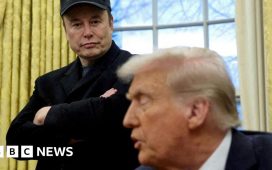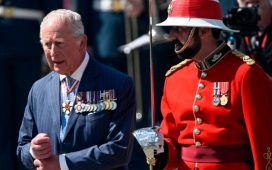Russia’s invasion of Ukraine sent shockwaves through the global economy and now, a year on from the start of the attack, the world is fundamentally changed.
Trends that were already in motion have accelerated, as the need to move away from fossil fuels to greener, renewable energy supplies became more urgent. Food prices have soared, increasing hunger in the developing world, and forcing governments, businesses and people to adapt to lasting shifts. Here we take a look at five ways the global economy has changed:
Inflation
The surge in global energy prices since the invasion has pushed inflation across advanced economies to its highest levels in decades, squeezing household incomes and weighing on economic growth. In the UK, soaring gas and electricity bills drove inflation to a peak of 11.1% in October, the highest level since 1981.
The inflation surge led central banks to increase interest rates, which drove up borrowing costs for households and businesses. Mortgage costs in the UK and several other nations have risen sharply, stoking fears of a property crash.
Economists expect inflation to cool rapidly over the coming months, as the initial surge in energy prices drops out of the calculation for the annual increase in rising living costs. However, gas and electricity prices remain much higher than before the invasion.
Jim Watson, director of the UCL Institute for Sustainable Resources, said: “By April, UK household bills will have trebled in the space of two years, pushing millions more households into fuel poverty.”
Green transition
Western nations have scrambled to cut their reliance on Russian oil and gas by building up domestic supplies, writes Damian Carrington. While this has involved renewed investment in fossil fuels, and reopened debates on fracking, windfall taxes and industry reform, Putin has also unwittingly accelerated the transition to renewables.
New analysis from Zero Carbon Analytics shows the EU has already found substitutes for nearly 75% of Russian fossil gas imports, and that global gas demand has plateaued for the first time. “Before its invasion of Ukraine, Russia was by far the world’s largest exporter of oil and natural gas,” it said. “Since the war, its standing has severely diminished. Flows of Russia’s pipeline gas to Europe have plummeted by 80% in just a year. At the same time, the cleaner alternatives to Russian fossil fuels are growing rapidly – renewable power capacity worldwide rose by about a quarter in 2022.”
Seb Kennedy of consultancy TransitionZero said Europe was now building renewable energy supplies at a faster pace: “The past year has seen a fundamental shift away from coal and gas power, with support for renewables taking on new urgency that shows no sign of waning.”
Global development
Russia and Ukraine are, respectively, the world’s largest and fifth-largest exporters of wheat, accounting for almost a third of global exports. They are also significant producers of fertilisers and other essential commodities. As war disrupts these supplies, food prices have rocketed to unprecedented levels.
While this has posed challenges globally, developing nations that are net food importers are particularly exposed. Countries in north Africa and the Middle East are among the biggest buyers of Russian and Ukrainian wheat.
But these poorer countries are facing a double whammy. Moves by the US Federal Reserve to raise interest rates in response to soaring inflation has pushed up the value of the dollar, making it more expensive for developing countries to import goods and borrow money on global markets denominated in the US currency.
Trade
International trade was already fragmenting before the Russian invasion, but the trend has been accelerated in the past year amid rising geopolitical tensions and concern over supply chain security. After the disruption caused by Covid, and with an eye on the conflict and shifting global relations, companies have pushed to reshore or “friendshore” production, bringing it closer to home.
Russia itself had relatively few export links with the rest of the world – it deals mainly in commodities – but has found itself further isolated as a result of sanctions. However, these were applied mainly by western countries; Russia’s trade with Asia, the Middle East, Africa and Latin America has grown.
Ian Stewart, chief economist in the UK at accountancy firm Deloitte, said: “The lure of cheap raw materials from Russia is spurring sanctions avoidance on a previously unseen scale. Russian oil shunned by the EU has found ready customers in China, India and Turkey.”
End of the oligarch?
Russia’s oligarchs lost almost $95bn last year as the result of sanctions: they have been shedding $330m a day ever since the Kremlin launched its invasion. Questions have been raised over whether the influence of the country’s politically connected business elite has been permanently diminished, after years of accumulating luxurious London properties, superyachts and football clubs.
Roman Abramovich, the former Chelsea FC owner, was the biggest loser, seeing his fortune fall by 57% to $7.8bn, according to the Bloomberg billionaires index.
However, there are signs that the clampdown hasn’t worked as well as had been hoped. Sanctions enforcement has proved patchy, with regulations varying widely between countries. Progress in the UK to close loopholes in transparency rules has been slow. Meanwhile, oligarchs have been offered shelter by jurisdictions outside the sanctions zone, such as Turkey and the UAE.









